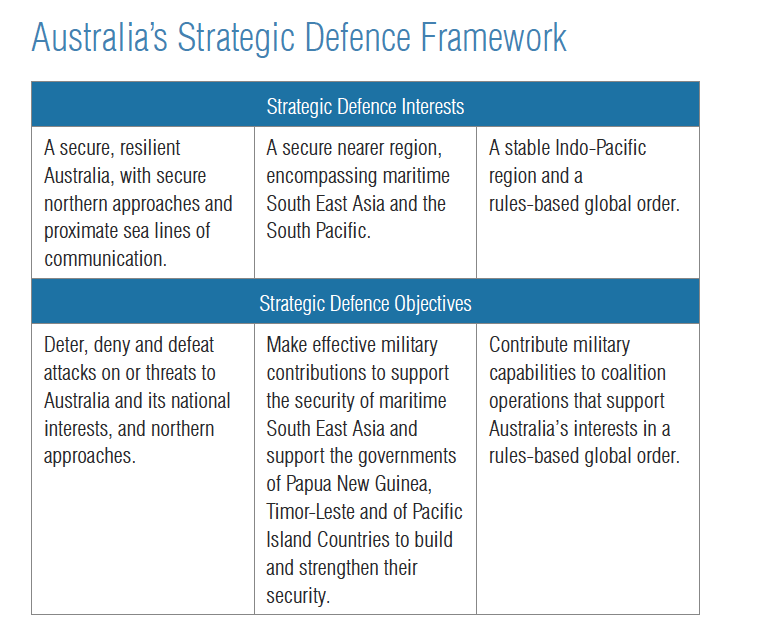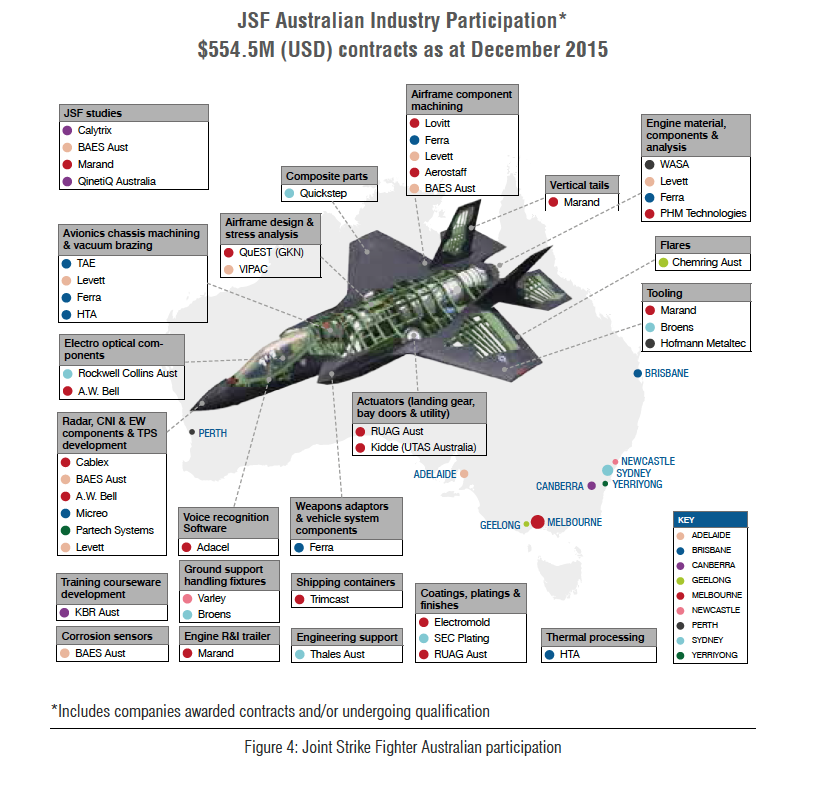2016-02-26 By Robbin Laird
The Australian government has recently released a new Defense White Paper along with two accompanying documents, a defense industrial policy statement as well as defense integrated investment program.
Together, these documents express the concern with the dynamics of change in the region and beyond, and Australia’s’ approach to shaping an agile, effective and integrated force to deal with these challenges and to enhance force interoperability with the U.S. and other allies in the region.

Reports which we issued earlier with regard to the Australian strategic reset, first with regards to the acquisition of the F-35, then with the launch of Plan Jericho by the Air Force, anticipated much of what is expressed in the new strategy.
https://www.sldinfo.com/plan-jericho-the-raaf-shapes-a-transformation-strategy-2/
And the launch of the Wedgetail as well as of the KC-30A program have presaged some of the key elements of the industrial strategy as well as the investment strategy.
Indeed, one can look at how the Aussies have worked with industry to deliver the most advanced air battle management system flying today as an example of working through a challenging program to deliver a core capability, and thereby shaping practical lessons for how to innovate.
https://www.sldinfo.com/the-wedgetail-as-a-trailblazing-program/
The acquisition of the KC-30A is also a case in point of how the Aussies have pioneered innovations in 21st century air tanking, and they did this largely on their own in close consultation with industry.
https://www.sldinfo.com/an-update-on-the-airbus-tanker-the-aussie-experience/
https://www.sldinfo.com/wp-content/uploads/2015/09/Update-on-Airbus-Tanker.pdf
https://www.sldinfo.com/the-kc-30a-and-wedgetail-the-raaf-shapes-a-way-ahead/
Neither was an easy acquisition but laid down a path that could lead to a fundamentl rethink in terms of how the MoD should work with the forces and with industry in shaping new capabilities.
At the heart of the strategy is to shape a more integrated and effective air, land, naval force able to operate at greater distance within the region and beyond.
There is a clear understanding expressed throughout the documents of the need to get beyond stove-piped acquisition and to work differently with industry. This will be challenging for the government and the services, to get beyond the normal requirements process and hands on control over that process and industry which clearly wants to sell platforms.
Indeed, what is striking about most of the coverage earlier this week in the press with regard to the new strategy is that the primary focus has been upon the new platforms to be built, rather than how they would be acquired and integrated into the force.
And one can look with difficulty when searching for this: “Australian Defence White Paper 2016 + Plan Jericho.”
Not many hits I can tell you.
The Defense White Paper highlights the evolving strategic environment and identifies the kind of force, which Australia needs to deal with that environment.
The core strategic interests for Australia are highlighted in the table below from the White Paper.

A clear and core point about how to deal with China and others who seek to remake the world in their image is the following:
“A stable rules-based regional order is critical to ensuring Australia’s access to an open, free and secure trading system, and mimize the risk of coercion and instability that would directly affect Australia’s interests.
A stable rules-based global order services to deal with threat before they become existential threats to Australia, and enables our unfetter access to trading routes, secure communication and transport to su0ppor Australia’s economic development (page 70 Defence White Paper).”

To do so requires an enhanced air-maritime force with a more mobile, agile and projectable ground force.
And the Defence Integrated Investment Program lays out current thinking about how to best achieve such an integrated force.

In the word’s of the White Paper, “The government will ensure Australia maintains a regionally superior ADF with the highest levels of military capability and scientific and technological sophistication.
The future force will be more capable, agile and potent.”
To do so requires building, evolving, and enhancing the decision making superiority of the forces, which is indicated a key foundation for everything else.
In other words, 21st century C2 is at the heart of any ability to leverage a more lethal and capable force.
And with regard to industry, although new platforms are being added, “the Integrated Investment Program addresses underinvestment in the key enablers that support and maximize Australia’s defense capability.
The focus on enablers will ensure our future force is appropriately supported, works coherently together as a whole, and is sustainable (page 11, Integrated Investment Program).
And driving the point home, the investment program highlights that narrowly focusing on platforms and platform acquisition will not get Australia where it needs to go with regard to its integrated forces.
This is why the future force is discussed in terms of capability streams, not simply the buying of platforms.

How to work with industry differently is seen as a key foundation block for getting to a more agile and integrated force. This is the focus of the Defence Industry Policy Statement.
This Defence Industry Policy Statement sets out the specific measures the Government will take to implement the Defence industry policy, including:
Streamlining the numerous Defence industry and innovation programs under two broad initiatives funded at around $1.6 billion1 over the decade to FY 2025–26:
Establishing a new Centre for Defence Industry Capability, led by an advisory board comprised of private sector and Defence representatives to drive the strategic partnership with Defence, involve industry in governance of the industry programs and provide a range of business and skilling services.
The Centre for Defence Industry Capability, and the associated collaborative activities with Defence, will be funded at around $230 million over the decade to FY 2025–26;
And fostering a new approach to innovation through closer collaboration between Defence, industry and research organisations to jointly develop game-changing innovation and commercialisation opportunities (pages 11-12 Defence Industry Policy Statement).

The Defence Industry Policy statement provides several examples of the Aussies are tackling the problem of innovation, which will get them where they need to go, rather than stove piped innovation.
An example cited is that of the Joint Strike Fighter program and the participation of Australia in that program.
The Joint Strike Fighter Program is about much more than just the delivery of a new fighter capability. It is a catalyst for change for both Australian Defence capability and outcomes for Australian defence industry.
The Program is an example of how a capability requirement can be used to build new global supply chain opportunities for competitive Australian defence industry.
The Program adopted a new capability acquisition strategy that allowed Australian industry to participate in all stages of the capability life cycle, from design through to sustainment.
Importantly, Defence’s Joint Strike Fighter Program Office includes an industry team which has brought about a cultural shift in the way industry and Defence capability managers engage.
As a result, the fifth generation aircraft is providing a pathway for industry to move closer to the heart of capability development and sustainment, effectively positioning industry as a Fundamental Input to Capability.
To date, a total of US$554.5 million in contracts has been secured by Australian defence industry in Joint Strike Fighter design and production, with more opportunities to become available as rates of aircraft production increase and the sustainment model develops.

The Joint Strike Fighter will be sustained by a global supply chain that will eventually service over 3000 F-35 aircraft worldwide.
Industry participation in the Joint Strike Fighter Program has been supported by other initiatives such as the Defence Industry Innovation Centre, enabling businesses to find competitive advantages through delivery of innovations, improved capacity, up-skilled staff, research partnerships and entry into export markets.
The improved competitiveness means Australian businesses are realising opportunities to diversify into other defence sectors and overseas markets, competing on the global stage.
Maximising opportunities for Australian defence industry in the global sustainment system for the Joint Strike Fighter will require an even closer relationship between industry and Defence in the future.
The global supply chain opportunities, provided to Australian defence industry through the Joint Strike Fighter Program, are a good example of how largescale capability projects can provide real benefit and growth to Australian small to medium enterprises.
Defence will, in collaboration with CDIC, seek to develop similar models for Australian industry involvement in future major ADF capability projects (pages 54-55 Defence Industry Policy Statement).

And interestingly, the Aussies have highlighted an aspect of the F-35 program which has been virtually invisible in the Inside the Beltway discussion of the program.
The Joint Strike Fighter will be interoperable with other ADF elements equipped with United States derived systems as well as United States forces.
The nature of the global partnership in developing and supporting the Joint Strike Fighter also extends an interoperability benefit more broadly with potential coalition partners, including within our region.
Regular updates to maintain a common and supportable configuration with the United States’ Joint Strike Fighter fleet will reduce the cost to Australia of upgrading the software and hardware to maintain its leading edge capabilities (page 96, Defence Integrated Investment Strategy).
I will be going to Australia next month for the Air Power Conference as well as the Williams Foundation’s latest contribution to supporting an innovative way ahead, this time with regard to air-land integration.
The Williams Foundation seminar on New Thinking on Air-Land is focused upon the following:
Air forces need to be capable of delivering air and space power effects to support conventional and special operations in the land domain. Air-Land integration is one of the most important capabilities for successful joint operations.

The last decade has seen a significant shift in how airpower has supported ground operations. With the introduction of systems like Rover, the ability of airpower to provide precision strike to the ground forces saw a significant change in fire support from a wide variety of air platforms. Precision air dropping in support of outposts or moving forces introduced new capabilities of support.
Yet this template of air ground is really focused on air support to the ground whereas with the shift in the global situation, a much wider set of situations are emerging whereby the air-ground integration approach will become much wider in character, and the ability to insert force rapidly, as a precision strike capability, and to be withdrawn will be a key tool in the toolbox for decision makers.
Fifth generation enabled operations will see a shift to a distributed C2 approach which will clearly change the nature of the ground-to air command system, and the with the ability of fifth generation systems to generate horizontal communications among air assets outside the boundaries of a classic AWACs directed system, the change in C2 will be very wide ranging.
The seminar will explore how the ADF can take advantage of Army’s Plan Beersheba and Air Force’s Plan Jericho to enhance Air-Land integration.
The seminar will be unclassified, by invitation mostly and at no cost to Defence members and Williams Foundation members (who have taken membership before 1 Jan 2016). Defence members can also send an expression of interest to ev****@********************rg.au
In other words, technologies, platforms and systems are driving changes in concepts of operations, and operational realities will, in turn, drive the demand for new technologies, and systems to enable the three dimensional warriors who will provide the agility, and reach which Australia is looking for to deal with 21st century strategic challenges.
For the White Paper and associated documents, please go to the following:
http://www.defence.gov.au/whitepaper/
For recent comments with regard to the Defence White Paper, see the following:
http://news.navy.gov.au/en/Feb2016/Events/2722/2016-Defence-White-Paper.htm#.VtAi6ZMrJBw
http://www.specops-dhp.com/defense-news/australian-defence-white-paper-and-special-operations/
http://www2.deloitte.com/au/en/pages/public-sector/articles/defence-white-paper-2016.html
http://www.airforce.gov.au/News/2016-Defence-White-Paper/?RAAF-KpVcR0nhTZ6IE3XZZW5ZKy9nQiQ++XCj

